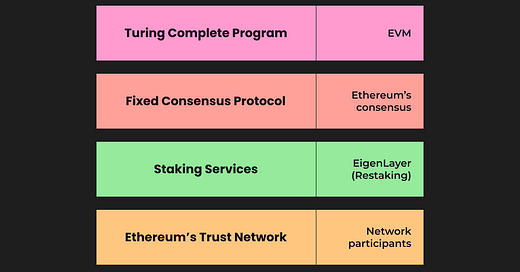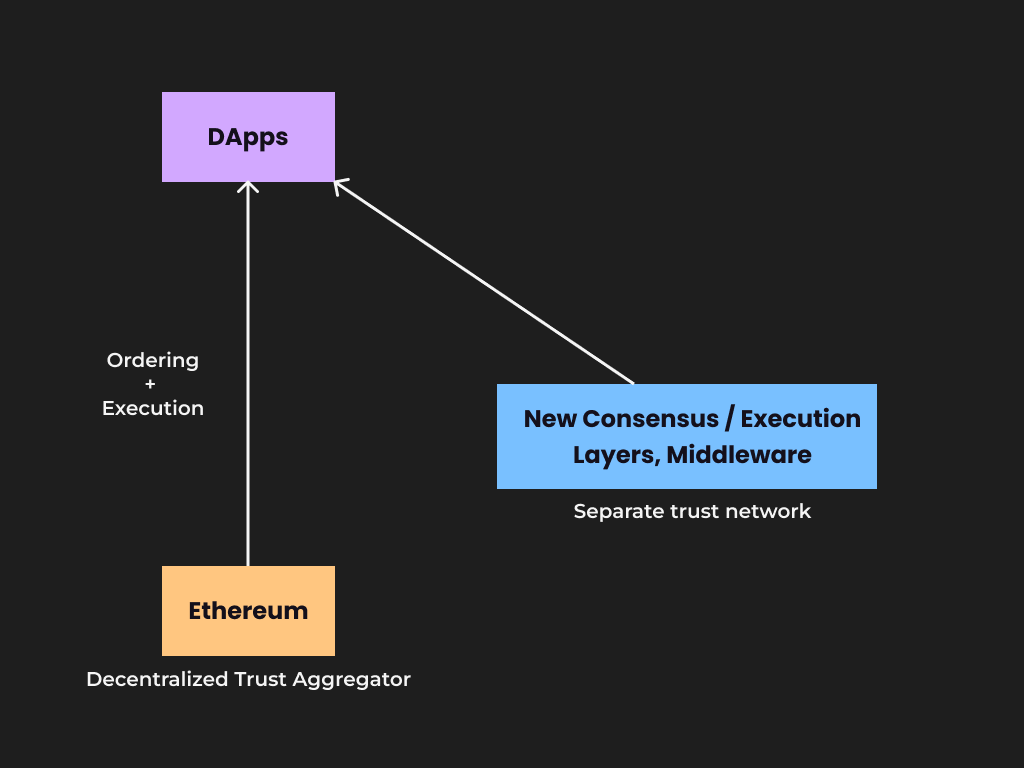A New Staking Primitive in Town
EigenLayer's re-staking lets protocols to leverage Ethereum's trust network, allowing innovation across all layers of the tech stack.
Fourteen years ago, Satoshi Nakamoto published the Bitcoin white paper on metzdowd's cryptography mailing list. Bitcoin's first version was released soon after, and its development was pivotal in pioneering decentralized computation. Multiple untrusted computers could now collaborate to achieve a unified computing environment.
Bitcoin was designed as a digital currency payment network, a cryptocurrency. Its scripting language was purposefully confined to simple true/false evaluations of spending conditions. Developers recognized the Bitcoin model's power. Some were trying to diversify beyond its cryptocurrency applications, but they faced a conundrum– either build on top of Bitcoin or start a new blockchain. Building on Bitcoin meant being constrained by its design and looking for workarounds. Only a few applications could run directly on Bitcoin; the majority required extra off-chain layers. This immediately nullified many advantages of using a public blockchain.
Any application requiring greater flexibility while remaining on-chain had to deploy a new network and re-establish decentralized trust. Each such application divided the available trust into smaller and smaller chunks. Deploying a new blockchain also meant a significant amount of extra labor. These issues prompted the creation of Ethereum– a Turing-complete, general-purpose blockchain. Ethereum's design abstracted away the complex inner workings of a blockchain and offered dApps a secure, deterministic programming environment. Developers could now launch any dApp without first establishing a decentralized trust network.
Ethereum equips dApps with a decentralized trust module, effectively decoupling trust and innovation. ETH fosters trust, while dApps foster innovation. This freed up a lot of room for developers to innovate. Earlier, they had to rebuild the wheel and build a network before they even got started. Today? All of that comes in the base package. The value exchange at work here is that the dApps receive Ethereum's trust in exchange for fees. The pseudonymous economy has resulted from this separation of innovation and trust; because trust is taken from Ethereum, anons can create expansive deFi protocols.
However, did Ethereum actually resolve the problem of generating decentralized trust?
The Problem
The first three levels of the system — trust network, consensus, and context — serve as the basis of Ethereum's trust module. Only the fourth layer — the application layer — permits innovation. Ethereum only provides trust in the context of block production, but numerous other applications require trust. To become an Ethereum validator, a participant must stake 32 ETH. The network can seize that stake from a validator if they don't follow the rules or behave maliciously. This substitutes the trust assumption with crypto-economic security. In order to replicate this effect, each service must spin out its own PoS network.
To begin, developing a new consensus layer or an execution model necessitates the creation of an entirely new network. They are unable to leverage Ethereum's security. They create separate trust networks, dividing the total ecosystem capital and trust into smaller fragments.
Second, Ethereum has to rely on externalities for things like message exchange across blockchains, oracles, and data availability. Middleware is developed to address such issues. Middleware protocols need to build a trust network from the ground up, which is both difficult and expensive. They fail to do so, and because their networks are significantly less robust than Ethereum's, they serve as a weak link. A network is only as strong as its weakest link. We’re facing the same problem once again: trust fragmentation.
Having middleware protocols build their own network of trust and security causes a massive increase in the cost of capital and labor. This hinders innovation. Furthermore, a proof-of-stake network must amass a significant amount of value to have reasonable security and trust. This also creates opportunities for negative value extraction because there is little incentive alignment between different networks
Enter Re-Staking
Eigen Layer allows a validator to subject their 32ETH to additional slashing criteria in exchange for providing a service. Eigen Layer aims to address the challenges associated with fragmented trust networks by providing a service that allows users who have locked in their ETH stake to "restake" their ETH in a different smart contract. In essence, this means subjecting the same capital to additional slashing conditions. Same capital, additional risk, additional rewards.
By making changes to Ethereum's base client layer, Eigen Layer enables validators to re-hypothecate their ETH stake and validate several protocols concurrently. This enables one to validate other protocols like oracles and data availability modules with staked ETH that has already been used to secure Ethereum. Each application will be able to establish a set of criteria that will cause a validator's stake to be slashed. Each validator can then undertake a risk/reward analysis to determine whether it is advantageous to run the application, and can run numerous such applications in parallel seamlessly.
Since none of these projects must create a new token as part of their trust layer because they can leverage ETH's robust security, this system results in zero marginal cost of capital. As a result of their shared security, this also aligns the values of the middleware being developed and Ethereum. This creates a feedback loop in which the more value a service provided using EigenLayer has, the better the return for ETH stakeholders, resulting in a higher value for ETH and ETH security, and the security for each EigenLayer project. This gives new projects an incentive to build on EigenLayer. The elimination of the need for protocols to build a secure trust network from the ground up would enable tremendous innovation that was previously only possible at the application level.
Re-Staking vs Merged Mining
Re-staking appears to be merged mining in the PoS realm. Re-staking, however, does not share merged mining's shortcomings when examined more closely.
The idea behind merged mining is to enable a new blockchain grow from the enormous proof-of-work network that underpins Bitcoin. It permits simultaneous mining for more than one blockchain, without affecting a miner's overall performance. The proof of work performed on one blockchain, known as the parent blockchain, can be used as valid work on another blockchain (called the auxiliary blockchain). Though it's an intriguing concept, it doesn't really stand up when practised. The Bitcoin miners have very little to lose if they decide to attack the auxiliary chain because the economic incentives for merged mining are poorly aligned. The security of the auxiliary chain is ultimately reduced by mergedmining since economic losses are eliminated from the process.
Whereas, trust in the PoS Ethereum is derived from its slashing conditions: any validator who does not follow the prescribed course of action or acts maliciously will have their stake slashed. Cryptoeconomic security replaces the trust assumption. If a validator violates a well-defined set of staking incentivization and slashing rules in any protocol created using EigenLayer, their ETH stake is slashed. By re-staking, a validator takes on additional risk and is rewarded according to whatever standards the protocols provide. The incentives, both positive and negative, are aligned as a result. Staking sought to create this alignment of incentives, which is why trust is borrowed more freely from PoS Ethereum.
A Step in the Right Direction
Since what EigenLayer is attempting to accomplish is so ambitious, they may fall short. Right now, it's difficult to say because a lot depends on how the idea is executed. More trust across all tiers of the tech stack makes Ethereum more robust. EigenLayer is a step towards that goal.
Further Reading:
What can be built using EigenLayer?
Thanks for reading, it means the world.
If you want to talk about a project you find interesting or just want to exchange memes, you can find me @gryptooo.











